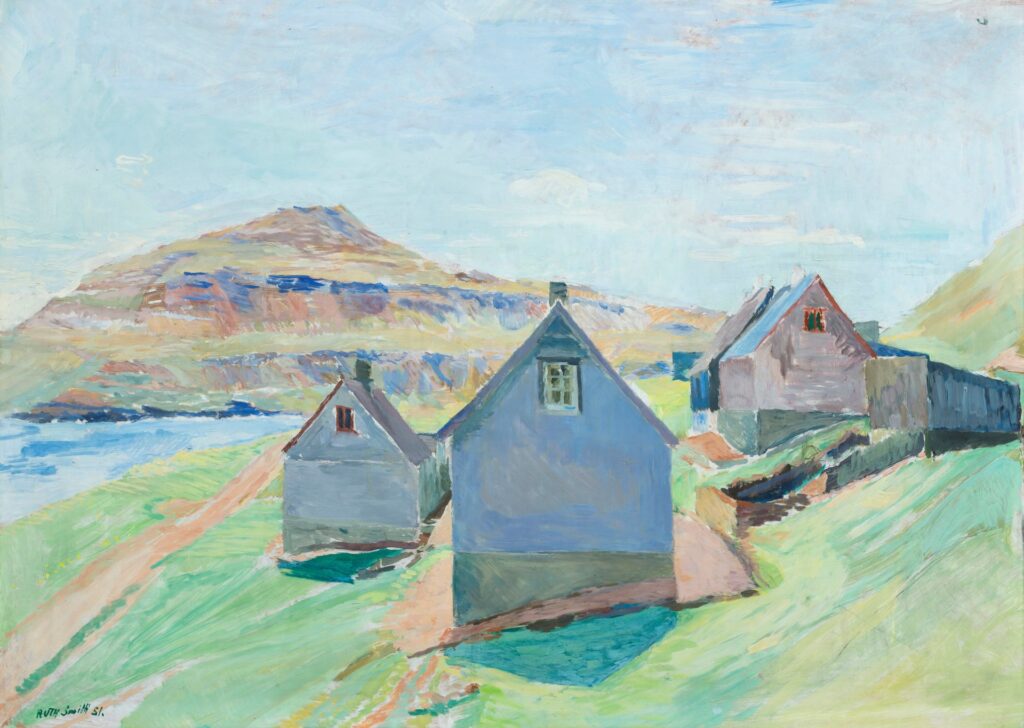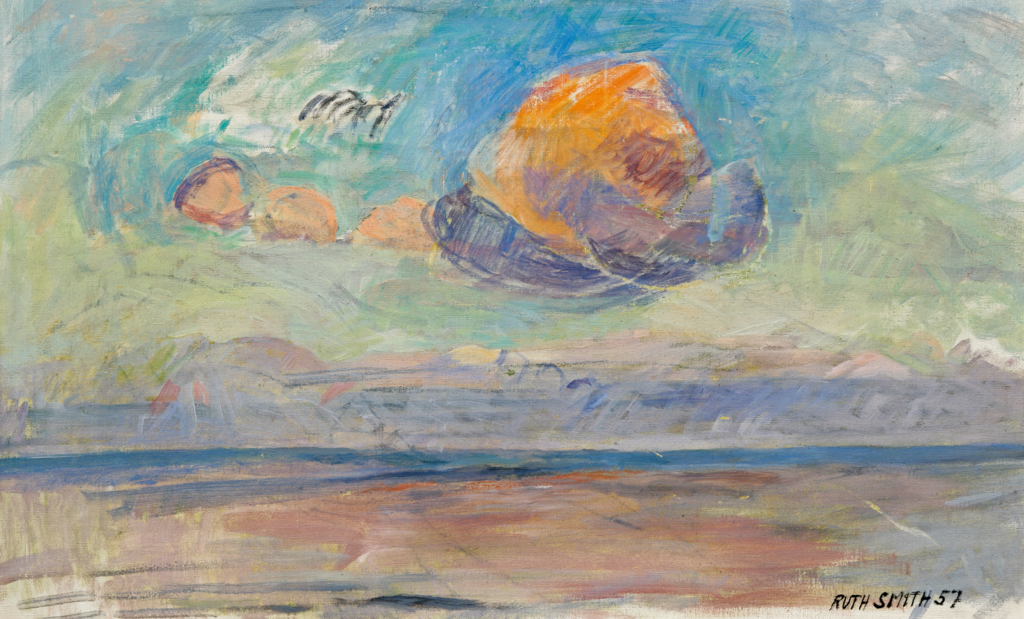Laura Knight in 5 Paintings: Capturing the Quotidian
An official war artist and the first woman to be made a dame of the British Empire, Laura Knight reached the top of her profession with her...
Natalia Iacobelli 2 January 2025
In celebration of the artistic spirit, we are delighted to present a special feature on a remarkable female artist from the Faroe Islands–Ruth Smith. Join us in an exploration of her life and learn about the masterpieces she crafted.
Our focus here is on unraveling the essence of Ruth Smith–her Faroese identity, her womanhood, and the sheer fabulousness that defined her. All three tie into the leading questions: What did it mean for her to be Faroese? To be a woman? And, how does that reflect in her art?
She lived in a discrepancy between herself as highly educated and respected artist in Denmark and herself as daughter, wife and mother in an isolated island hamlet where the later role was clearly defined with a knitting needle in hand rather than a paint brush.
Moderne Kunst der Färöer Inseln. Modern Art from the Faroe Islands. Leopold Museum/Listasavn Føroyar, Wien/Tórshavn, p. 18.
Dagmar Warming’s quote summarizes the artist’s main internal conflict throughout her grown-up life. Born in 1913 in Vágur on the island of Suðuroy (Faroe Islands), Ruth Smith was one of 5 siblings. Her father died of tuberculosis when she was only 9 years old. Her mother, Elin Caroline Smith, was left alone with the children and the family business, a paint store. Money was tight and Ruth started working at just 15 years old to help support her family. Two years later, she moved to Denmark to become a nurse.
While working at a diaconal hospital in Frederiksberg, Denmark, one of the patients saw a watercolor Christmas card painted by Ruth. Impressed by the young woman’s artistic work, he encouraged her to apply to Bizzie Højers art school.
A step in the right direction was made. After a short stay back in the Faroe Islands, Ruth applied to the art academy in Copenhagen and was accepted in 1936. She then studied under Professor Aksel Jørgensen for about 7 years.
During her years at the academy, Smith met Danish architect Poul Morell Nielsen. The couple passionately discussed literature, philosophy, and Marxist theory with each other. These contentions with politics and ideology stood in contrast to Smith’s very religious upbringing as part of the Open Brethren, an evangelical Christian movement that started in Ireland at the beginning of the 19th century. Their belief in salvation and condemnation of the soul had a long-lasting impact on Smith.

Ruth Smith, Við Neytalið, 1951, Listasavn Føroya, Tórshavn, Faroe Islands.
Ruth gave birth to her and Poul’s first son, Leif, in 1947. The following year, the three moved back into Smith’s childhood home in Vágur, where they lived together with her extended family in quite cramped conditions for about two years.
In 1950, the young family moved to a village to the east. The painting Við Neytalið shows the artist’s view from their rented house in the village of Nes, which the family called home at that time.
What is remarkable about this painting is the high positioning of the light which is shown through the positioning of the shadows of the houses The light in Við Neytalið can easily compete with contemporary works by artists such as Ingálvur av Reyni.
Ruth Smith’s life back in her home country was not fabulous at all. The married couple and their two sons (the second born in 1952) were seen as strangers by the villagers of Nes. Poul’s Danish origin was met with suspicion of being a Nazi meanwhile Smith’s painting was seen as a waste of time.
Social pressure, financial issues, and general isolation were hard burdens for the young artist. Things got even heavier when her elderly mother moved in with the family. The couple needed a bigger house, and Smith needed a studio in which she could paint.
Caring for a loved one grappling with depression and psychosis became overwhelming for Smith. Her younger sister, Hanna Smith, made the difficult decision to relocate their mother to a hospital in Denmark.
Ruth, burdened with a sense of failure, felt she had missed the opportunity for a final reunion. The longing for a deeper connection with her mother finds expression in the painting Móðir mín created the year her mother moved away. The artwork is characterized by a striking red-blue contrast interrupted by hues of yellowish-white. A true marvel of coloristic artistry, this piece skillfully plays with tones and nuances in both light and shadow.
In the following years Smith would create some of her most iconic self-portraits and captivating landscape paintings, notable for their deliberately unfinished quality. It is widely suggested that the self-portraits reveal the artist’s deteriorating eyesight and the deepening melancholy of her mental state.
Consequently, some interpret these paintings as a form of foreshadowing of the artist’s tragic demise in 1958 at the young age of 45. An alternative theory proposes that Smith may have suffered from meningitis associated with a tuberculosis infection. This illness, characterized by the invasion of bacteria into the nervous system, could have played a significant role in her untimely death.

Ruth Smith, Skýggj og blá luft II, 1957, Listasavn Føroya, Tórshavn, Faroe Islands.
On the morning of May 28, 1958, Ruth Smith’s lifeless body was discovered on the foreshore of Vágsfjørð after being missing for over 24 hours. She lay between two stones, dressed only in a nightgown. Witnesses described her appearance as peaceful, almost as if she were asleep. Clutched in her hand was some seaweed. The circumstances leading to her death remain unknown, but it is presumed that she had been in the water and the cold likely played a role in her demise. At the age of 45, Ruth Smith passed away.
The panoramic view of the fjord from Smith’s homeland became a recurring motif in her final years. The painting Skýggj og blá luft II (above), with its portrayal of a perfectly calm sea, possesses an otherworldly quality. Nils Ohrt aptly describes it as a symbol of the artist’s yearning for freedom, tranquility, and peace.
Fuhr, Michael & Dagmar Warming (2007): Moderne Kunst der Färöer Inseln. Modern Art from the Faroe Islands. Leopold Museum/Listasavn Føroyar, Wien/Tórshavn.
Ohrt, Nils (2021): Millum Føroyar og málningin – Samuel Joensen-Mikines, Ruth Smith, Ingálvur av Reyni. Listasavn Føroyar, Tórshavn.
DailyArt Magazine needs your support. Every contribution, however big or small, is very valuable for our future. Thanks to it, we will be able to sustain and grow the Magazine. Thank you for your help!